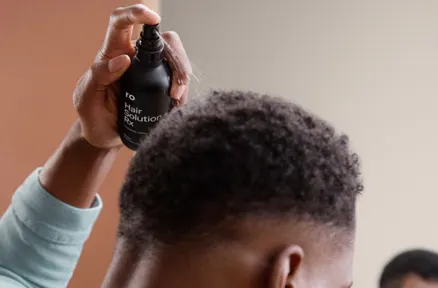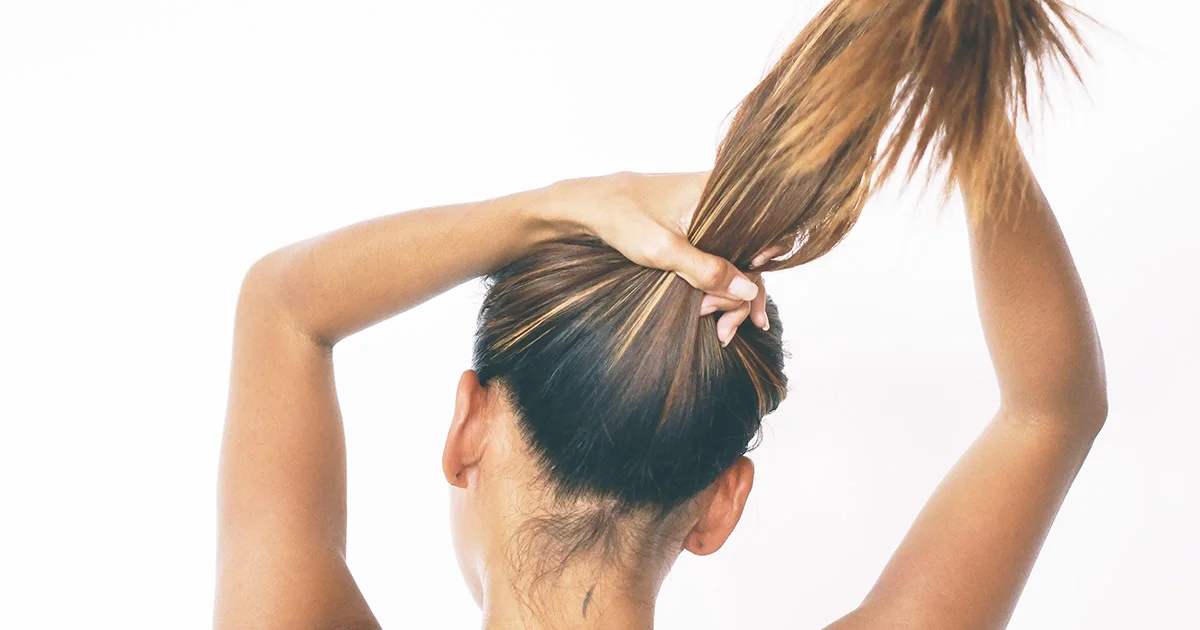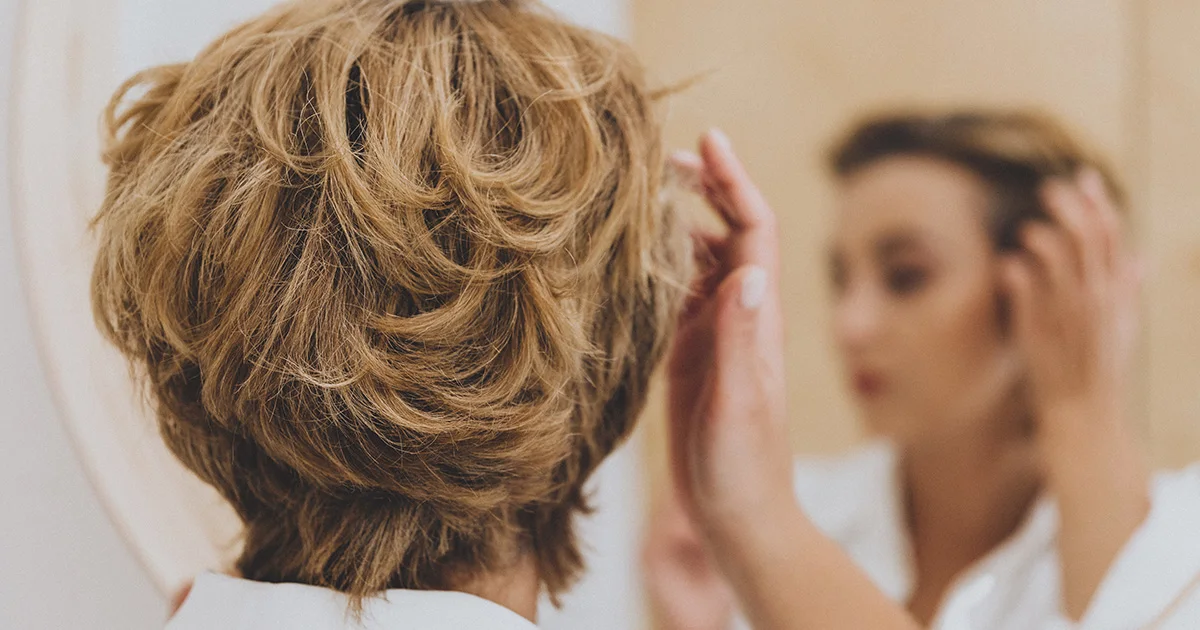Here's what we'll cover
Here's what we'll cover
Your hairline is the place on your forehead or scalp where your hair begins. If you have an uneven hairline, hair growth on one side of your scalp doesn’t match the other (Azar, 2016).
Most of the research on uneven hairlines has involved people who have experienced signs of hair loss. That work has found that as hair recedes, uneven hairlines are quite common. However, even if you don’t have a receding hairline, you may have an uneven hairline (Gupta, 2016).
Let’s take a closer look at the causes of uneven hairlines, how they differ for males and females, and if it’s possible to “fix” them.
What is an uneven hairline?
An uneven hairline is an asymmetry (aka, an imbalance) between the left and right sides of your hairline.
For example, the right side of your hairline may begin a little (or even a lot) farther back on your scalp than the left side. Some research has found that this right-side imbalance may be more common than a left-side imbalance (Azar, 2016).
It’s worth mentioning that your hair “line” is not really a line at all. Just as the trees that form the edge of a forest usually do not create a perfectly straight or uniform line, the hairs on your head grow in a way that creates only a rough line made up of lots of hairs of different lengths and diameters (Park, 2015).
What causes an uneven hairline?
Many parts of the body are not perfectly symmetrical.
For example, most human faces possess some left-right unevenness. Unless you’re trying hard to spot these asymmetries, you normally won’t notice them (Thiesen, 2015). Your internal organs and other parts of your body also often possess asymmetry (Nöthe-Menchen, 2019). Likewise, dermatology researchers who have studied uneven hairlines have found that they tend to be both common and subtle (Azar, 2016).
While the exact biological underpinnings of uneven hairlines aren’t known, in general, body asymmetry is caused by normal variations in the expression of genes that influence growth and development (Nöthe-Menschen, 2019).
Researchers have found that hairline asymmetry may be caused specifically by age-related hormonal changes, problems with the adrenal glands, or as a result of congenital (birth) disorders (Sirinturk, 2017).
Uneven hairline: male vs. female
The common cause of hair loss—whether your hairline is even or uneven and whether you’re male or female—is androgenetic alopecia, another term for genetic hair loss.
Androgenetic alopecia also goes by the names “male pattern baldness” or “female pattern hair loss,” and people with a family history of hair loss are at greater risk for it (Torabi, 2020).
Androgenic alopecia is a common condition that can result in many types of hair loss, hair thinning, or bald spots. Roughly 80% of men and 42% of women will experience thinning hair or hair loss in their lifetimes (Kanti, 2018).
In people with androgenetic alopecia, the cause of hair loss is due to genetic factors that turn on androgen receptors, which cause the growth cycle of hair follicles to shorten over time. This causes the hairs to grow shorter and shorter—to the point where they may no longer be visible at all (Ho, 2021).
Uneven hairlines in men
Men and women who experience hair loss tend to have different hairlines and different patterns of hair loss. Hair loss in men often shows up most in the hairline and creates a widow’s peak or V-shape as it recedes toward the back of the head.
So, uneven hairlines in males may show up as a more pronounced hollow or “recession” on one side of the scalp. In other words, the V-shape formed by the hair loss is deeper on one side than on the other (Azar, 2016).
Uneven hairlines in women
Women usually have a rounder hairline, and hair loss tends to show up first on the top of the head, where it then works its way out (Gupta, 2016). So, uneven hairlines in women may disrupt the normally round shape of their hairlines. For example, the hair may be more sparse on one side (Park, 2015).
How to fix an uneven hairline
An uneven hairline is usually considered a “cosmetic” issue—meaning it may not look appealing, but it’s not a medical problem.
Again, most uneven hairlines are going to be so subtle that they probably don’t require any kind of corrective procedure. However, hair transplant surgery and other hair treatments or hair restoration procedures can correct hairline asymmetry or other forms of hair loss (Jimenez, 2021).
A hair transplant procedure involves removing hair from another part of the scalp or body and implanting it where it’s needed. A dermatologist or hair-transplant specialist can correct an uneven hairline using this procedure (Park, 2015).
Other hair loss treatment options, such as laser therapy, may also be helpful. Topical solutions or prescription solutions such as finasteride (Propecia) or minoxidil (Rogaine), which can lead to hair regrowth and prevent hair fall, may also be helpful (Kanti, 2017).
The bottom line: If your hairline is uneven, it likely isn’t a big (or noticeable) issue. But if it’s more pronounced, there are ways to fix it.
Finasteride Important Safety Information: Read more about serious warnings and safety info.
DISCLAIMER
If you have any medical questions or concerns, please talk to your healthcare provider. The articles on Health Guide are underpinned by peer-reviewed research and information drawn from medical societies and governmental agencies. However, they are not a substitute for professional medical advice, diagnosis, or treatment.
Azar, R. P., Thomas, A. H., Maurer, M., et al. (2016). Asymmetry of the Receding Hairline in Men With Early Androgenetic Alopecia. Journal of Cutaneous Medicine and Surgery , 20 (6), 546–549. doi:10.1177/1203475416658470. Retrieved from https://pubmed.ncbi.nlm.nih.gov/27421295/
Gupta, M. & Mysore, V. (2016). Classifications of Patterned Hair Loss: A Review. Journal of Cutaneous and Aesthetic Surgery , 9 (1), 3–12. doi:10.4103/0974-2077.178536. Retrieved from https://www.ncbi.nlm.nih.gov/pmc/articles/PMC4812885/ .
Ho, C. H., Sood, T., & Zito, P. M. (2021). Androgenetic Alopecia. StatPearls . Retrieved May 10, 2022 from https://www.ncbi.nlm.nih.gov/books/NBK430924/
Jimenez, F., Alam, M., Vogel, J. E., et al. (2021). Hair transplantation: Basic overview. Journal of the American Academy of Dermatology , 85 (4), 803–814. doi:10.1016/j.jaad.2021.03.124. Retrieved from https://clinicadelpelo.com/wp-content/uploads/2021/10/HT-Part-I-published-online.pdf
Kanti, V., Messenger, A., Dobos, G., et al. (2018). Evidence-based (S3) guideline for the treatment of androgenetic alopecia in women and in men - short version. Journal of the European Academy of Dermatology and Venereology : JEADV , 32 (1), 11–22. doi:10.1111/jdv.14624. Retrieved from https://onlinelibrary.wiley.com/doi/full/10.1111/jdv.14624 .
Nöthe-Menchen, T., Wallmeier, J., Pennekamp, P., et al. (2019). Randomization of Left-right Asymmetry and Congenital Heart Defects: The Role of DNAH5 in Humans and Mice. Circulation. Genomic and Precision Medicine . doi:10.1161/CIRCGEN.119.002686. Retrieved from https://www.ahajournals.org/doi/full/10.1161/CIRCGEN.119.002686
Park, H. S., Kim, J. Y., Choe, Y. S., et al. (2015). Alternative method for creating fine hairs with hair removal laser in hair transplantation for hairline correction. Annals of Dermatology , 27 (1), 21–25. doi:10.5021/ad.2015.27.1.21. Retrieved from https://anndermatol.org/DOIx.php?id=10.5021/ad.2015.27.1.21
Sirinturk, S., Bagheri, H., Govsa, F., et al. (2017). Study of frontal hairline patterns for natural design and restoration. Surgical and Radiologic Anatomy : SRA , 39 (6), 679–684. doi:10.1007/s00276-016-1771-1. Retrieved from https://www.researchgate.net/profile/Yelda-Pinar/publication/309905416_Study_of_frontal_hairline_patterns_for_natural_design_and_restoration/links/5b0ba666aca2725783ea6367/Study-of-frontal-hairline-patterns-for-natural-design-and-restoration.pdf
Thiesen, G., Gribel, B. F., & Freitas, M. P. (2015). Facial asymmetry: a current review. Dental Press Journal of Orthodontics , 20 (6), 110–125. doi:10.1590/2177-6709.20.6.110-125.sar. Retrieved from https://www.scielo.br/j/dpjo/a/T5y5gcRSXMynWpdBbNb3SkN/?lang=en
Torabi, P., Behrangi, E., Goodarzi, A., et al. (2020). A systematic review of the effect of platelet-rich plasma on androgenetic alopecia of women. Dermatologic Therapy , 33 (6), e13835. doi:10.1111/dth.13835. Retrieved from https://onlinelibrary.wiley.com/doi/full/10.1111/jdv.14624










